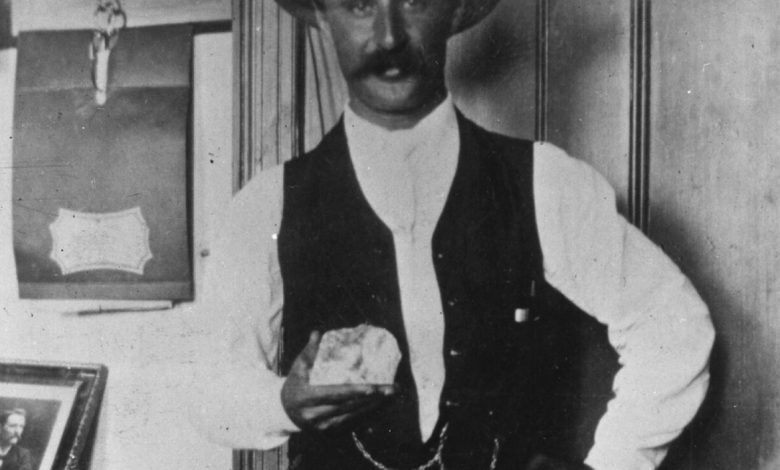The Cullinan Diamond’ The Star of Africa Diamond

The discovery of the Cullinan Diamond in Transvaal, South Africa, in 1905 marked a momentous event in the world of gemstones.
Weighing well over 3,000 carats, it earned the title of the largest gem-quality rough diamond ever unearthed.
Gifted to Edward VII of England by the Transvaal Government, the diamond held a staggering value of over $21 million in today’s currency at the time of its discovery.
Despite its immense value, the Cullinan Diamond embarked on a remarkable journey from South Africa to England.
The rough stone, with a rich history tied to the Premier Mine near Pretoria, was sent via registered post.
Upon its arrival in England, the massive diamond underwent meticulous cutting, resulting in nine large gemstones named Cullinan I to IX, along with 96 smaller diamonds.
The Cullinan Diamond’ The Star of Africa Diamond
The grandeur of the Cullinan Diamond is epitomized by Cullinan I, also known as the Star of Africa, a majestic 530-carat diamond.
This remarkable gem now adorns the royal sceptre within the British Crown Jewels, standing as the largest colorless cut diamond globally.
Cullinan II, the second-largest stone at 317 carats, known as the Second Star of Africa, found its place in the Imperial State Crown, a prominent fixture in the coronation ceremonies of British monarchs.
Other significant diamonds from the Cullinan, each carrying a distinct name, became part of royal adornments, including pendants and brooches, forming a cherished segment of the royal family’s private jewelry collection.
Cullinan Diamon Discovery
The diamond’s discovery on January 26, 1905, was attributed to Frederick G. S. Wells, the Surface Manager at the Premier Mine, who received a substantial bonus for the find.
The massive uncut diamond, boasting 3,106 carats and remarkable purity, became an unparalleled example in the world of diamonds. It was first exhibited at the Standard Bank of Johannesburg.
In a peculiar twist, the Cullinan stone, in its raw state, was sent to London in 1907 to find a suitable buyer. Astonishingly, the diamond was sent via registered mail, while a decoy was used to mislead potential thieves.
Despite its safe arrival, no private buyers expressed interest. Motivated by the Prime Minister of Transvaal, General Louis Botha, the Transvaal Government acquired the diamond from the Premier Mine Company for £150,000.
The decision was then made to present the Cullinan Diamond as a gift to King Edward VII of England for his 66th birthday in 1907.
This grand gesture aimed to mend relations between Britain and South Africa following the Second Boer War.
The diamond was transported under police escort to Sandringham House in Norfolk, where it was presented to the king.
Subsequently, the king entrusted its care to Scotland Yard until a decision was made on its future.
Cullinan’ The Sovereign Sceptre
In early 1908 it was decided to cut the rough and opaque diamond into brilliant gemstones.
In order to get ideas on what exactly to do with the hoped-for gems, a team of experts visited the British Crown Jewels in the Tower of London to see where they might be installed.
The precious stone was then sent to the diamond experts Joseph Asscher and Company of Amsterdam for cutting.
The process to cut out and polish sparkling gems from the huge mass of rough stone began in February 1908 and took the team of three specialists eight months to complete.
The original piece was first cut into two pieces weighing 516.5 and 309 carats. The groove for the first cut alone took four days to prepare and when Joseph Asscher himself attempted to make it, the steel knife snapped.
A second attempt was successful, and the original stone was eventually cut into seven large pieces.
Cullinan’ The Largest Cut Diamond in the World
These were then cut and polished to produce nine large stones, each being given the rather unimaginative name of Cullinan plus a Roman numeral from I to IX.
Cullinan I and II were formally presented to Edward VII on 21 November 1908, almost exactly one year after he had first set eyes on the uncut stone.
This pair of gems, then the largest cut diamonds in the world, were immediately put on public (and very safe) display in the Tower of London.
The pear-shaped Cullinan I was the largest stone of the group, weighing a massive 530.2 carats – the famous Koh-i-Noor diamond from India, also part of the British Crown Jewels, weighs a mere 105.6 carats.
Cullinan I is the largest colourless top-quality cut white diamond in the world and the magnificent gem did at least benefit from a new and more romantic name: the Star of Africa.
Initially, Cullinan I and Cullinan II were paired together in what must have been a dazzling but rather impractical pendant brooch.
Following Edward VII’s death in 1910 there was a rethink of just what to do with these magnificent jewels.
ALSO READ: African Countries with the Highest Number of UNESCO World Heritage Sites
African Countries with the Highest Number of UNESCO World Heritage Sites
ALL SEVEN CULLINAN DIAMONDS (III-IX) ARE PART OF THE JEWELLERY COLLECTION OF THE ROYAL FAMILY
The Cullinan I
It was added to the Sovereign’s Sceptre, ready for the coronation of George V (r. 1910-1936) in 1911 CE.
This is, in fact, what the original design team had decided the largest stone should be used for back in 1908.
The sceptre, which is also known as the King’s Sceptre, was made in 1661 for the coronation of Charles II of England (r. 1660-1685), and it symbolises worldly regal power and good governance.
The stone is cradled upright between a two-armed gold mounting at the top of the sceptre which allows it to be seen from all angles.
This mounting is hinged to easily allow the stone to be removed. Due to the extra weight of the diamond, it was necessary to reinforce the length of the sceptre.
Above the diamond is an amethyst monde, itself set with diamonds and one large emerald. The sceptre, which measures 92.2 cm in length, was part of the regalia used by Queen Elizabeth II at her coronation in 1953.
Cullinan II: Resplendent in the Imperial State Crown
The illustrious Cullinan II, an oval-shaped diamond weighing an impressive 317 carats and affectionately known as the Second Star of Africa, emerged as the second-largest gem cut from the original Cullinan Diamond.
In 1910, this extraordinary gem found its esteemed place within the gold Imperial State Crown, alternatively named the Crown of State.
Originally crafted for the coronation of Queen Victoria in 1838 as a lighter alternative to the traditional St. Edward’s Crown, it continued to grace significant coronation ceremonies.
Noteworthy appearances of the Imperial State Crown, adorned with the resplendent Cullinan II, include the coronations of Edward VII, George VI, and Elizabeth II.
Positioned at the forefront of the crown’s band, just below the renowned Black Prince’s Ruby, Cullinan II has become an integral part of the crown’s regal ensemble.
The Stewart Sapphire, initially in this position, yielded its place to accommodate Cullinan II.
Beyond coronations, the Imperial State Crown makes regal appearances at various state events, including the annual State Opening of Parliament.
The crown, along with the sceptre featuring Cullinan I, is showcased for public admiration in the Jewel House within the Tower of London’s Waterloo Barracks.
Much like its counterpart, Cullinan II can be easily detached from its crown setting, allowing it to be worn as a pendant or brooch, showcasing its versatility and magnificence.
The legacy of the Cullinan Diamond extends beyond Cullinan II, with other remarkable gems derived from the original diamond:
-
Cullinan III:
A pear-shaped diamond weighing 94.40 carats, set into the finial of Queen Mary’s Crown. It can be worn alongside Cullinan IV as a pendant-brooch.
-
Cullinan IV:
A cushion-shaped diamond weighing 63.60 carats, initially set in the band of Queen Mary’s crown. It complements Cullinan III and can be worn as jewelry.
-
Cullinan V:
A triangular-pear cut weighing 18.80 carats, initially mounted in a brooch for Queen Mary, serving as a replacement for the Koh-i-noor in the circlet of her crown.
-
Cullinan VI:
An 11.50-carat marquise-cut stone, gifted by King Edward to Queen Alexandra, now worn by Queen Elizabeth II as a drop on a diamond and emerald necklace.
-
Cullinan VII:
An 8.80-carat marquise-cut stone mounted in a pendant on a small diamond brooch, accompanied by the 6.80-carat cushion-cut Cullinan VIII.
-
Cullinan IX:
A 4.39-carat pear-shaped diamond, mounted in a ring with a prong setting, initially made for Queen Mary and still worn by Queen Elizabeth II.
The mystique surrounding the Cullinan Diamond persists, with speculation hinting at the possibility of another undiscovered piece or the existence of a fragment awaiting revelation.
While the latter is improbable, the allure of unearthing more treasures from the Cullinan Diamond continues to captivate miners and prospectors alike, adding an element of excitement to their endeavors.





